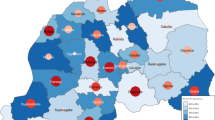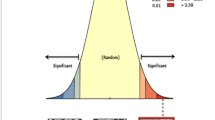Abstract
This study used data from the Demographic and Health Surveys to examine the prevalence and correlates of Intimate Partner Violence (IPV) against men in Africa. Nationally representative data from 12 countries was analysed using a Spatial Latent Gaussian Model to capture the linear and non-linear nature of covariates while accounting for spatial heterogeneity. The results showed that female perpetrated abuse was significantly associated with education, alcohol consumption, intergenerational cycle of violence, polygamy, wealth, and type of union. As far as age of perpetrator (female) or victim (male) and spousal age difference were concerned, they had a non-linear effect on IPV. Furthermore, the spatial effects highlighted lack of spatial autocorrelation between the prevalence of IPV as one moves from country to country.








Similar content being viewed by others
References
Abel, E. M. (2001). Comparing the social service utilization, exposure to violence, and trauma symptomology of domestic violence female “victims” and female “batterers”. Journal of Family Violence, 16, 401–420.
Abramsky, T., Watts, C. H., Garcia-Moreno, C., Devries, K., Kiss, L., Ellsberg, M., Jansen, H. A. F. M., & Heise, L. (2008). What factors are associated with recent intimate partner violence? Findings from the WHO multi-country study on women’s health and domestic violence. BMC Public Health, 11(1), 109–125.
Anderson, K. L. (1997). Gender, status, and domestic violence: an integration of feminist and family violence approaches. Journal of Marriage and the Family, 59(3), 655–669.
Babcock, J. C., Miller, S. A., & Siard, C. (2003). Toward a typology of abusive women: differences between partner-only and generally violent women in the use of violence. Psychology of Women Quarterly, 27, 153–161.
Bernard, M. L., & Bernard, J. L. (1983). Violent intimacy: the family as a model for love relationships. Family Relations, 32, 283–286.
Besag, J., & Kooperberg, C. (1995). On conditional and intrinsic autoregressions. Biometrika, 82, 733–746.
Besag, J., Green, P. J., Higdon, D., & Mengersen, K. (1995). Bayesian computation and stochastic systems (with discussion). Statistical Science, 10, 3–66.
Brinkerhoff, M. B., & Lupri, E. (1988). Interspousal violence. Canadian Journal of Sociology, 13(4), 407–434.
Brownridge, D. A. (2008). The elevated risk for violence against cohabiting women: a comparison of three nationally representative surveys of Canada. Violence Against Women, 14(7), 809–832.
Brownridge, D. A., & Halli, S. S. (2001). Explaining violence against women in Canada. Lanham: Lexington.
Campbell, D. (2010). More than 40% of domestic violence victims are male, report reveals [online]. Available from: http://www.theguardian.com/society/2010/sep/05/men-victims-domestic-violence. Accessed 5 Jan 2015.
Carney, M. M., & Buttell, F. P. (2004). Psychological and demographic predictors of treatment attrition among women assaulters. Journal of Offender Rehabilitation, 38, 7–25.
Coker, A. L., Smith, P. H., McKeown, R. E., & King, M. J. (2000). Frequency and correlates of intimate partner violence by type: physical, sexual, and psychological battering. American Journal of Public Health, 90, 553–559.
CPES. (1999). Integrated weight for the pooled CPES data set [online]. Available from: http://www.icpsr.umich.edu/icpsrweb/CPES/about_cpes/weighting/integrated_weight.jsp. Accessed 23 Nov 2014.
DeKeseredy, W. S., & Schwartz, M. D. (1998). Measuring the extent of woman abuse in intimate heterosexual relationships. A critique of the Conflict Tactics Scales. U.S.
DeMaris, A., Benson, M. L., Fox, G. L., Hill, T., & Van Wyk, J. (2003). Distal and proximal factors in domestic violence: a test of an integrated model. Journal of Marriage and Family, 65(3), 652–667.
Dutton, D. G, Nicholls, T. L, & Spidel, A. (2005). Female perpetrators of intimate abuse [online]. Available from: http://www.HaworthPress.com. Accessed 8 Jan 2015.
Ellsberg, M. C. (2000). Candies in hell: Research and action on domestic violence against women in Nicaragua. Umeå: Umeå University.
Egeland, B. (1993). A history of abuse is a major risk factor for abusing the next generation. In R. J. Gelles & D. R. Loseke (Eds.), Current controversies on family violence (pp. 197–208). Newbury Park
Fahrmeir, L., & Lang, S. (2001a). Bayesian semiparametric regression analysis of multicategorical timespace data. Annals of the Institute of Statistical Mathematics, 53, 10–30.
Fahrmeir, L., & Lang, S. (2001b). Bayesian inference for generalized additive mixed models based on Markov random field priors. Journal of the Royal Statistical Society: Series C: Applied Statistics, 50, 201–220. doi:10.1111/1467-9876.00229.
Fong, Y., Rue, H., & Wakefield, J. (2010). Bayesian inference for generalized linear mixed models. Biostatistics, 11(3), 397–412.
Hines, D. A., & Saudino, K. J. (2002). Intergenerational transmission of intimate partner violence; a behavioural genetic perspective. Trauma, Violence & Abuse, 3(3), 210–225.
Hindin, M. J., Kishor, S., & Ansara, D. L. (2008). Intimate partner violence among couples in 10 DHS countries: Predictors and health outcomes. DHS Analytical Studies No. 18. Calverton, Maryland, USA: Macro International Inc.
Hoyle, A. (2013). Why are so many MEN becoming victims of domestic violence? It’s one of Britain’s last remaining taboos, but abuse against men in the home is on the rise [online]. Available from: http://www.dailymail.co.uk/femail/article-2518434/Why-MEN-victims-domestic-violence-Its-Britains-remaining-taboos-abuse-men-home-rise.html. Accessed 5 Jan 2015.
ICF International. (2012). Demographic and health surveys. Calverton: ICF International [Distributor].
Jackson, N. A. (1996). Observational experiences of intrapersonal conflict and teenage victimization: a comparative study among spouses and cohabitors. Journal of Family Violence, 11(3), 191–203.
Jewkes, R. (2002). Intimate partner violence: causes and prevention. Lancet, 359(9315), 1423–1429.
Johnson, K. (2003). Dialectics of power and violence in the home: A comparative analysis of women’s experience of domestic violence in Haïti and Nicaragua. Dissertation, University of Maryland.
Johnson, M. P., & Ferraro, K. J. (2000). Research on domestic violence in the 1990s: making distinctions. Journal of Marriage and the Family, 62, 948–963.
Kang, S. Y., McGree, J., & Mengersen, K. (2013). The impact of spatial scales and spatial smoothing on the outcome of Bayesian spatial model. PloS One, 8(10), e75957. doi:10.1371/journal.pone.0075957.
Kelsall, J. E., & Wakefield, J. C. (1998). Modeling spatial variation in disease risk. Tech. Rep., Imperial College London.
Kishor, S. (2000). Empowerment of women in Egypt and links to the survival and health of their infants. In H. B. Presser & G. Sen (Eds.), Women’s empowerment and demographic processes: Moving beyond Cairo. New York: Oxford University Press.
Kishor, S., & Bradley, S. E. K. (2012). Women’s and men’s experience of spousal violence in two African countries: Does gender matter? DHS Analytical Studies No. 27. Calverton: ICF International.
Kishor, S., & Johnson, K. (2004). Profiling domestic violence—A multi-country study. Calverton: ORC Macro.
Labell, L. S. (1979). Wife abuse: a sociological study of battered women and their mates. Victimology, 4(2), 258–267.
Lang, S., & Brezger, A. (2004). Bayesian P-splines. Journal of Computational and Graphical Statistics, 13(1), 183–212.
Lang, A. R., Goeckner, D. J., Adesso, V. T., & Marlatt, G. A. (1975). The effects of alcohol on aggression in male social drinkers. Journal of Abnormal Psychology, 84, 508–518.
Langhinrichsen-Rohling, J., Neidig, P., & Thorn, G. (1995). Violent marriages: gender differences in levels of current violence and past abuse. Journal of Family Violence, 10, 159–176.
Leonard, K. E. (2005). Alcohol and intimate partner violence: when can we say that heavy drinking is a contributing cause of violence. Addiction, 100, 422–425.
Maletta, H. (2007). Weighting [online]. Available from: http://www.spsstools.net/static/resources/WEIGHTING.pdf. Accessed 1 Jan 2015.
Malhotra, A., & Mather, M. (1997). Do schooling and work empower women in developing countries? The case of Sri Lanka. Sociological Forum, 12(4), 599–630.
Martin, S. L., Tsui, A. O., Maitra, K., & Marinshaw, R. (1999). Domestic violence in northern India. American Journal of Epidemiology, 150(4), 417–426.
Rue, H., & Held, L. (2005). Gaussian Markov random fields: Theory and application. Boca Raton: Chapman and Hall/CRC.
Rue, H., & Martino, S. (2006). Approximate Bayesian inference for hierarchical Gaussian Markov random fields models. Journal of Statistical Planning and Inference, 137, 3177–3192.
Rue, H., Martino, S., & Chopin, N. (2007). Approximate Bayesian inference for latent gaussian models using integrated nested laplace approximations. Statistics Report No. 1, Department of Mathematical Sciences, Norwegian University of Science and Technology, Trondheim, Norway.
Rue, H., Martino, S., & Chopin, N. (2009). Approximate Bayesian inference for latent Gaussian models using integrated nested laplace approximations (with discussion). Journal of the Royal Statistical Society, Series B, 71, 319–392.
Rue, H., Martino, S., Lindgren, F., Simpson, D., Riebler, A. (2013). INLA: functions which allow to perform a full Bayesian analysis of structured additive models using integrated nested laplace approximation. R package version 0.0, URL http://www.r-inla.org.
Rutstein, S., & Johnson, K. (2004). The DHS wealth index. Calverton: ORC Macro.
Rutstein, S. O., & Rojas, G. (2006). Guide to DHS statistics. Demographic and Health Surveys, Calverton: ORC Macro.
Sampson, R. J., & Laub, J. H. (1993). Crime in the making. Cambridge, MA: Harvard University Press.
Shillington, et al. (1995). Is there a relationship between “heavy drinking” and HIV high risk sexual behaviours among general population subjects? International Journal of Addiction, 30, 1453–1478.
Steinmetz, S. K. (1977–78). The battered husband syndrome. Victimology: An International Journal, 2, 499–509.
Stets, J. E., & Straus, M. A. (1989). The marriage license as a hitting license: a comparison of assaults in dating, cohabiting, and married couples. Journal of Family Violence, 4(2), 161–180.
Straus, M. A. (1979). Measuring intrafamily conflict and violence: the conflict tactics (CT) scales. Journal of Marriage and the Family, 41(1), 75–88.
Straus, M. A. (1990). Measuring intrafamily conflict and violence: The conflict tactic (CT) scales. In M. A. Straus & R. J. Gelles (Eds.), Physical violence American families: Risk factors and adaptions to violence in 8, 145 families (pp. 29–47). New Brunswick: Transaction Publishers.
Straus, M. A., & Gelles, R. J. (1992). How violent are American families? Estimates from the national family violence resurvey and other studies. In M. A. Straus & R. J. Gelles (Eds.), Physical violence in the American family (pp. 95–112). New Brunswick: Transaction Publishers.
Verma, V., Gagliardi, F., & Feretti, C. (2009). On pooling of data and measures. Working paper no. 84. Siena: University of Siena.
Woolf, N. Q. (2014). Our attitude to violence against men is out of data [online]. Available from: http://www.telegraph.co.uk/men/thinking-man/10752232/Our-attitude-to-violence-against-men-is-out-of-date.html. Accessed 8 Jan 2015.
World Health Organization. (2001). Putting women first: Ethical and safety recommendations for research on domestic violence against women. Department of Gender and Women’s Health. Geneva: WHO.
World Health Organization. (2005). World report on violence and health. Geneva: WHO.
Author information
Authors and Affiliations
Corresponding author
Rights and permissions
About this article
Cite this article
Tsiko, R.G. A Spatial Latent Gaussian Model for Intimate Partner Violence Against Men in Africa. J Fam Viol 31, 443–459 (2016). https://doi.org/10.1007/s10896-015-9784-9
Published:
Issue Date:
DOI: https://doi.org/10.1007/s10896-015-9784-9




